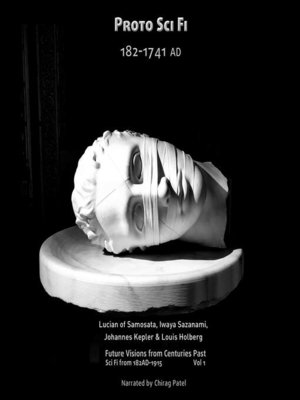Proto Sci Fi 182-1741AD
audiobook (Unabridged) ∣ The very first speculative fiction tales, translated from the Latin, Dutch & Japanese · Future Visions From Centuries Past
By Lucian of Samoa

Sign up to save your library
With an OverDrive account, you can save your favorite libraries for at-a-glance information about availability. Find out more about OverDrive accounts.
Find this title in Libby, the library reading app by OverDrive.



Search for a digital library with this title
Title found at these libraries:
| Library Name | Distance |
|---|---|
| Loading... |
This volume includes works that we would now recognize as science fantasy, with tropes such as exploring civilizations on the moon and strange devices with magical powers. It includes:
A True Story, Lucian of Samosata, c. 182. Written partly as a response to the inventions in other 'histories' of the Roman era, which were often as much fantasy and rumor as fact, this story is the earliest known work to include space travel, aliens, liquid air, robots, interplanetary warfare, and worlds with different rules of physics.
The Tale Of The Bamboo Cutter, Ozaki, c.939. From the oldest extant Japanese folk narrative, this work is also known and in film as "The Tale of Princess Kaguya'. In today's terms, it is the first work of speculative fiction, concerned with encounters with beings of impossible power, and a princess whose home and people are on the Moon.
Somnium, Johannes Kepler, 1609. A novel written by the astronomer whose name is still known today, described by Carl Sagan and Isaac Asimov as one of the first works of science fiction. Describes a culture and civilization on the Moon.
The Man In The Moone, Francis Godwin, 1638. Drawing on contemporary theories of Copernicus, Kepler, Galileo, and Gilbert, the inhabitants of the Moon in this story are a tall Christian people encountered by a roguish hero who must learn of their lands, and gains items that allow the control of light, heat, and gravity. Described by Edgar Allen Poe as "a singular and somewhat ingenious little book", it was a direct influence on Jules Verne and HG Wells.
Niels Klim's Journey Under The Ground, Louis Holberg, 1741. Originally written in Latin, this is the first book in the "hollow Earth" genre. It concerns a traveler who falls into orbit around the inner sun, and must learn the ways of a strange six-armed people that populate the inner surface of the Earth.







